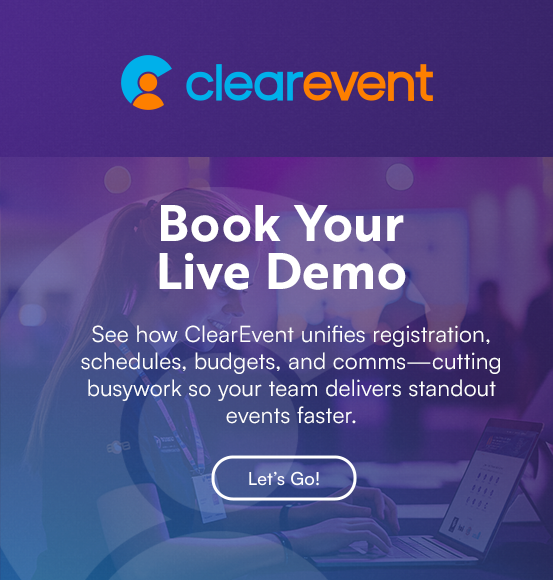Event Sponsorship: Maximizing the Value for Sponsors

If you’ve ever struggled to prove sponsor ROI or wondered how to give sponsors more than just a logo spot, you’re not alone. In today’s competitive event landscape, event sponsorship is about more than visibility; it’s about creating measurable results and meaningful engagement that benefits both sponsors and attendees. With the right approach, you can deliver.
Understanding Your Event’s Value
Before you can maximize sponsorship ROI, you need to understand the inherent value your event brings. This starts with a clear picture of your audience.
Ask yourself:
- Who attends your event?
- What are their demographics and interests?
- How does this audience align with a sponsor’s target market?
Collecting this data through event registration forms and attendee surveys helps you position your event as a strong marketing channel for potential sponsors.
Using Event Planning Tools for Deeper Insights
Modern event planning tools provide analytics and reports that go far beyond attendance counts. For example, you can:
- Track attendee demographics such as age, location, and interests.
- Identify which sessions or activities attract the most attention.
- Share engagement metrics that highlight sponsor exposure.
These insights help you demonstrate clear value and make it easier to design sponsorship packages that resonate.
Strategies for Promoting Sponsors
Once you know your audience, the next step is to ensure sponsors enjoy the sponsor visibility they deserve by using proven sponsor promotion strategy. This is more than a logo placement, it’s about weaving sponsors into the attendee experience.
Offer Customized Sponsorship Packages
Go beyond one-size-fits-all offers. Tailor packages based on sponsor goals. For example:
- A local restaurant could sponsor catering and receive branded menu placements.
- A technology company might prefer a sponsored breakout session or Q&A panel.
- Community organizations could co-host networking activities to connect directly with attendees.
By aligning packages with sponsor objectives, you increase perceived value and deliver stronger sponsorship ROI.
Create Engaging Content and Experiences
Make sponsors part of the experience with interactive activities. Consider:
- Branded activities like photo booths or prize giveaways.
- Sponsored learning sessions where sponsors share expertise.
- Social media challenges that encourage attendees to engage with sponsor hashtags.
These strategies create authentic touchpoints between your audience and sponsors.
Leveraging Technology for Sponsor Visibility
Technology helps integrate sponsors into your event in ways that feel seamless and engaging:
- Mobile Event Web App: Offer sponsors banner placements, sponsored messages, or featured listings within your event’s app or portal.
- Email Campaigns: Highlight sponsors in pre-event emails and event reminders.
- Event Portal or Website: Dedicate space for sponsor profiles, logos, and special offers.
Each of these channels keeps sponsor messages in front of attendees before, during, and after your event.
Measuring Sponsorship Impact
To keep sponsors coming back, you need to prove their investment worked. Reporting on sponsorship ROI shows sponsors the tangible benefits of their partnership.
Practical Ways to Measure ROI
- Track attendance at sponsored sessions or activities.
- Report impressions from sponsor listings, emails, or app notifications.
- Share social media engagement linked to sponsor hashtags or campaigns.
- Provide post-event surveys that capture attendee recognition of sponsors.
When you can demonstrate clear returns, sponsors are far more likely to renew, and increase, their investment in future events.
Maximizing event sponsorship means thinking beyond traditional placements. By using data, tailoring packages, and integrating sponsors into the attendee journey, you’ll create true partnerships that deliver results for everyone involved.
Whether you’re running a community event, managing multiple clients, or planning your organization’s annual conference, the right event planning tools make sponsorship success achievable.
Ready to elevate your event sponsorship strategy? Explore how modern event planning tools can simplify your process, improve sponsor visibility, and maximize your sponsorship ROI.
Frequently Asked Questions (FAQ)
What are the best ways to increase sponsor visibility at events? Combine traditional methods like logo placement with digital strategies such as mobile event web app banners, sponsored email campaigns, and interactive activities. This creates multiple touchpoints that keep sponsors top of mind throughout the event.
How do I prove sponsorship ROI to potential or returning sponsors? Track key metrics like session attendance, social media engagement, and sponsor mentions in event communications. Share these results in a clear post-event report to demonstrate the tangible impact of sponsorship.
What type of sponsorship packages work best for small community events? Smaller events benefit from creative, localized sponsorships such as catering, signage, or community activity sponsorships. Tailor packages to highlight sponsor goals while keeping costs accessible and relevant to your audience.
How early should I approach sponsors for an upcoming event? Begin outreach at least 4–6 months before your event. This gives sponsors enough time to allocate budget, plan their activations, and maximize exposure before, during, and after the event.
Do virtual or hybrid events offer the same sponsorship opportunities as in-person events? Yes, but the approach is different. Virtual events rely more on digital placements, sponsored sessions, and online networking, while hybrid events can combine in-person engagement with virtual reach to expand sponsor visibility.
